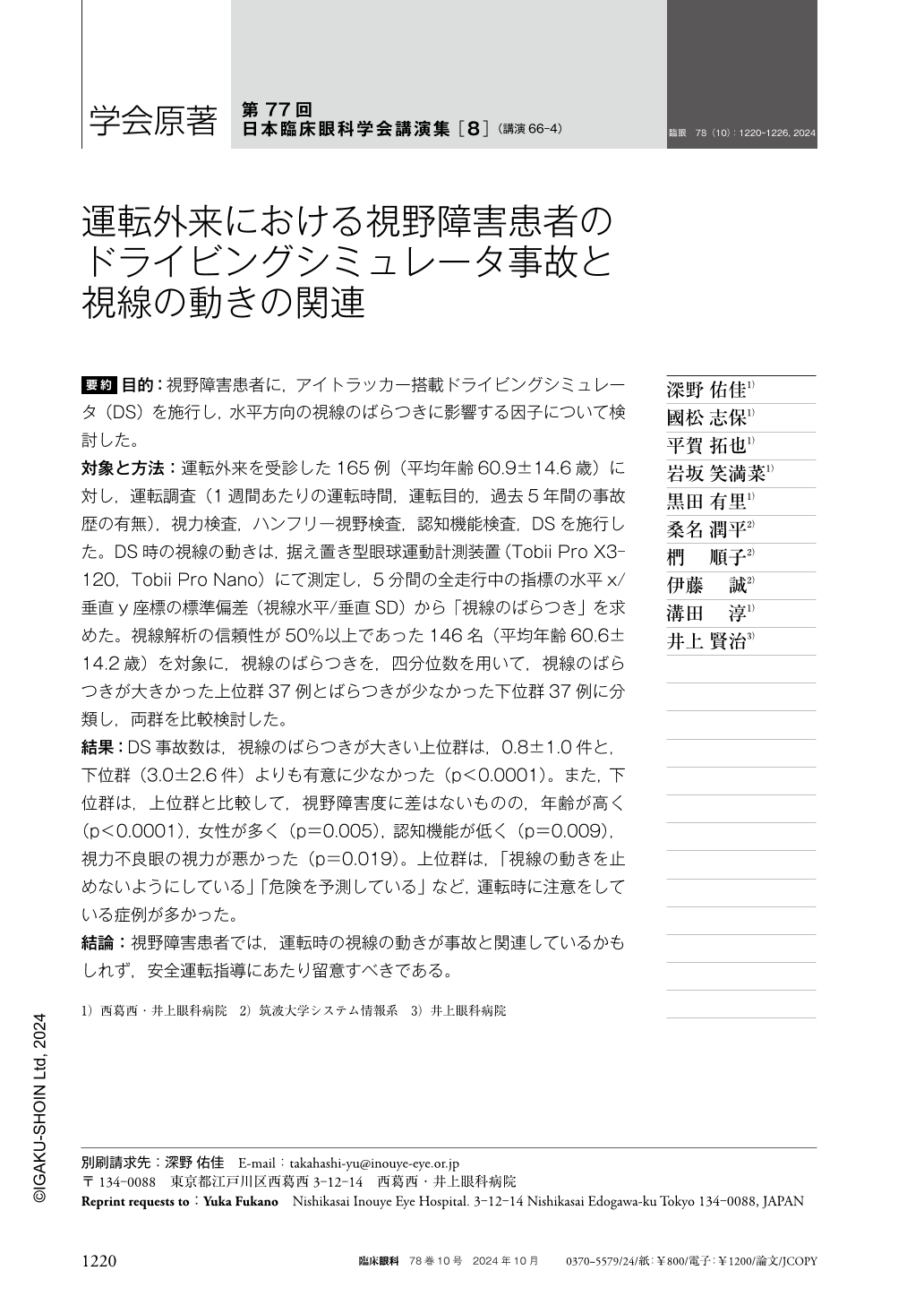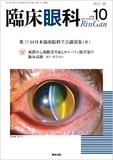Japanese
English
- 有料閲覧
- Abstract 文献概要
- 1ページ目 Look Inside
- 参考文献 Reference
要約 目的:視野障害患者に,アイトラッカー搭載ドライビングシミュレータ(DS)を施行し,水平方向の視線のばらつきに影響する因子について検討した。
対象と方法:運転外来を受診した165例(平均年齢60.9±14.6歳)に対し,運転調査(1週間あたりの運転時間,運転目的,過去5年間の事故歴の有無),視力検査,ハンフリー視野検査,認知機能検査,DSを施行した。DS時の視線の動きは,据え置き型眼球運動計測装置(Tobii Pro X3-120,Tobii Pro Nano)にて測定し,5分間の全走行中の指標の水平x/垂直y座標の標準偏差(視線水平/垂直SD)から「視線のばらつき」を求めた。視線解析の信頼性が50%以上であった146名(平均年齢60.6±14.2歳)を対象に,視線のばらつきを,四分位数を用いて,視線のばらつきが大きかった上位群37例とばらつきが少なかった下位群37例に分類し,両群を比較検討した。
結果:DS事故数は,視線のばらつきが大きい上位群は,0.8±1.0件と,下位群(3.0±2.6件)よりも有意に少なかった(p<0.0001)。また,下位群は,上位群と比較して,視野障害度に差はないものの,年齢が高く(p<0.0001),女性が多く(p=0.005),認知機能が低く(p=0.009),視力不良眼の視力が悪かった(p=0.019)。上位群は,「視線の動きを止めないようにしている」「危険を予測している」など,運転時に注意をしている症例が多かった。
結論:視野障害患者では,運転時の視線の動きが事故と関連しているかもしれず,安全運転指導にあたり留意すべきである。
Abstract Purpose:To assess factors influencing the horizontal spread of search during driving using a driving simulator(DS).
Methods:One hundred and sixty-five patients(mean age 60.9±14.9 years)from our driving assessment clinic underwent DS(Honda Motor Co, Tokyo)testing with eye tracking(Tobii Pro X3-120, Tobii Pro Nano). All patients were examined with the Humphrey Field Analyzer. Cognitive function was assessed using the Mini Mental State Examination. The patients' best point-by-point monocular sensitivity was considered. Horizontal and vertical spread of search was calculated based on the standard deviations of the x- and y- coordinates of eye movement during a five-minute session of running. One hundred and forty-six subjects(mean age 60.6±14.2 years)for whom the reliability of eye tracking was greater than 50% were categorized into the largest quartile(37 cases)and smallest quartile(37 cases)of horizontal spread of search for comparative analysis.
Results:The subjects in the largest quartile of horizontal spread of search had significantly less collisions in DS(P<0.0001)compared to those in the smallest quartile(0.8±1.0 vs. 3.0±2.6). The smallest quartile group was also older(P<0.0001)and, predominantly female(P=0.005), and had lower cognitive function(P=0.009)and worse visual acuity in the worse eye(P=0.019). Despite no difference in visual field impairment, the largest quartile group demonstrated a higher prevalence of attention-paying behaviors while driving, such as “keeping the gaze moving rather than fixating on a single point” and “anticipating danger.”
Conclusions:In drivers with visual field impairment, eye movements while driving may be associated with motor vehicle collision. Increased eye movement associated with anticipating danger during driving is crucial when teaching safe driving.

Copyright © 2024, Igaku-Shoin Ltd. All rights reserved.


